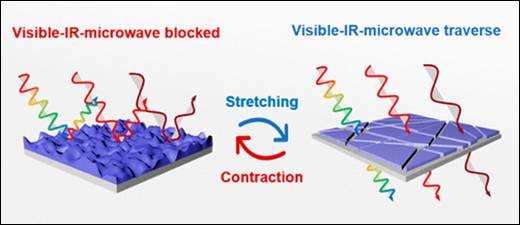Squid-inspired Material Controls Transmission of Light, Heat and Microwaves - Prof Jason Xu Zhichuan
We are pleased to share that Professor Jason Xu and his team have been featured in various media platforms for having developed a squid-inspired soft material that can dynamically transition between transparent and shielding states across a wide spectrum of electromagnetic waves simultaneously, from visible light to microwave.
The adaptive multispectral mechano-optical system that they have developed is inspired by the appearance-changing skin of cephalopods and consists of bilayer films of acrylic dielectric elastomer and silver nanowire. By applying mechanical strain, the system can switch between different surface morphologies, such as wrinkles and cracks, which in turn alters its optical, thermal and microwave properties. The squid-inspired soft material's ability to repeatedly and rapidly modify its transparency has the potential to revolutionise dynamic camouflage technologies, energy-efficient buildings, as well as adaptive personal and healthcare devices.
A paper on this discovery, which involved Prof Xu and his team of collaborators from Nanjing University, was published in ACS Nano titled "An Adaptive Multispectral Mechano-Optical System for Multipurpose Applications".
.jpg?sfvrsn=ecebbe44_3)
Abstract Mechano-optical systems with on-demand adaptability and a broad spectrum from the visible to microwave are critical for complex multiband electromagnetic (EM) applications. Most existing material systems merely have dynamic optical or microwave tunability because their EM wave response is strongly wavelength-dependent. Inspired by cephalopod skin, we develop an adaptive multispectral mechano-optical system based on bilayer acrylic dielectric elastomer (ADE)/silver nanowire (AgNW) films, which reconfigures the surface morphology between wrinkles and cracks via mechanical contraction and stretching. Such morphological evolution regulates the direct transmission/reflection and scattering behavior of visible–infrared light and simultaneously alters the conductive network in a AgNW film to influence its microwave characteristics. The designed system features switching between visible–infrared–microwave transparency and opacity, continuous regulation, wide spectral window (0.38–15.5 μm and 24,200–36,600 μm), excellent recyclability (500 times), and rapid response time (<1 s). These grant the system great potential as platforms for various promising applications such as smart windows, switchable EM devices, dynamic thermal management, adaptive visual stealth, and human motion detection. (https://doi.org/10.1021/acsnano.3c01836) |  |
About ACS Nano
ACS Nano is an international forum for the communication of comprehensive articles on nanoscience and nanotechnology research at the interfaces of chemistry, biology, materials science, physics, and engineering. It also helps facilitate communication among scientists from these research communities in developing new research opportunities, advancing the field through new discoveries, and reaching out to scientists at all levels. According to the Journal Citation Reports (Clarivate Analytics, 2023), the journal has a 2022 impact factor of 17.1. For more about the journal, visit ACS Nano.
Our heartiest congratulations to Prof Xu and his team on this excellent achievement!














/enri-thumbnails/careeropportunities1f0caf1c-a12d-479c-be7c-3c04e085c617.tmb-mega-menu.jpg?Culture=en&sfvrsn=d7261e3b_1)

/cradle-thumbnails/research-capabilities1516d0ba63aa44f0b4ee77a8c05263b2.tmb-mega-menu.jpg?Culture=en&sfvrsn=1bc94f8_1)






